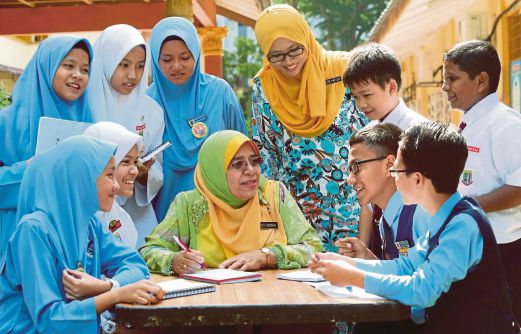
Published by Malay Mail, image from New Straits Times.
According to the World Health Organization (WHO), approximately 16 million teenage girls give birth each year.
In Malaysia, an average of 18,000 teenage girls get pregnant each year, and 25 per cent of those cases involve pregnancy out of wedlock. Experts from the UM Specialist Centre (UMSC) believe that teenage pregnancy is on the rise.
Additionally, since 2008, a staggering number of 1,075 cases of baby dumping were recorded, and according to Deputy Prime Minister Dr Wan Azizah Wan Ismail, sexual abuse cases of 20,000 Malaysian children were hidden by the former Barisan Nasional government for over 10 years.
Clearly we’re seeing a trend of sexually-related problems due to a lack of awareness and knowledge regarding sexual and reproductive health (SRH) education.
Currently, sex education is included under the physical and health education (PE) syllabus. However, according to Deputy Education Minister Teo Nie Ching, some teachers replace PE classes with other subjects which they consider more “useful”.
This negligence towards sex education has had visible consequences throughout the years. One study in 2015 explored postgraduate students’ understanding of and beliefs about sexual and reproductive health. Results showed that most of them believed that sexually transmitted diseases could be spread by shaking hands (92.1 per cent).
The study concluded that the level of sexual and reproductive health knowledge is not satisfactory and that there are still some misconceptions about sexual issues. If this is the case amongst postgraduate students from the age of 20 to 46, then what more the younger generation?
Challenges to sex education in Malaysia
Tackling the issue of misconceptions regarding sexual issues requires going to the root of it all — SRH education in schools. Malaysia is relatively conservative compared to Western countries when it comes to discussing sex-related issues.
Even Teo, Deputy Minister of Education, mentioned that sex education was placed under PE because it is still a largely taboo topic amongst Malaysians. One word about sex and you’ll be met with disapproving stares.
The reason sex-related issues have been demonised so much is partly due to religion. In major religions of the world such as Islam and Christianity, fornication and adultery is forbidden. However, somewhere along the way, this prohibition has translated into a complete shunning of anything sex-related. This is further amplified by the media and public discourse mostly highlighting the negative aspects of sexuality.
One paper published in 2017 looked at mothers’ views about sexual health education for their adolescent daughters in Iran. Barriers to SRH education presented by the paper included embarrassment surrounding discussions of this issue with their daughters and a lack of skills for effective communication.
These barriers are also relevant in the context of Malaysia. Embarrassment about discussing sexual health issues leads to complete unawareness regarding SRH. Like a chain reaction, this perception is carried on from one generation to another, eventually becoming deeply rooted in a society’s customs.
It wouldn’t be wrong to say that some Malaysians fear the implementation of SRH education would somehow encourage youngsters to engage in sexual activities. However, a 2012 article found that although male adolescents were at risk of having permissive attitudes toward sexual behaviors, good knowledge on sexual and reproductive health and being more religious may protect them from harmful sexual behaviours.
What’s next?
The first step that needs to be taken by the government is to make SRH its own subject. It cannot be shoved into one chapter under PE or biology. It must have its own slot and syllabus since SRH education is extensive. It is not just explaining about the birds and the bees, it is talking about the whole ecosystem.
A holistic approach must be taken in producing an appropriate syllabus for the subject. Topics such as the basics of the reproductive system, sexually transmitted diseases and contraceptives must be covered.
Besides that, a chapter on basic hygiene and healthcare would greatly help those going through puberty and experiencing the menstrual cycle for the first time. Elaboration on early detection of genitalia infections and consequences of being unsanitary would help youngsters to be more aware of their bodies.
Emphasis must be given on the topic of family planning as well as its’ health and financial consequences to ensure that youth are aware of these factors when building a family. Moreover, child marriage and its negative consequences must also be talked about.
Other than that, the syllabus should also include a topic on consensual sex and inappropriate touching. Saying no to sexual coercion is not a crime. Perhaps several helplines could be provided to report abuse or sexual violence.
In addition, the current age of social media necessitates media literacy as younger and younger children browse these platforms. These children should be made aware of the dangers of these platforms, and precautions that should be taken to ensure secure online browsing.
Of course, the implementation of all of this is not possible without the support of everyone – be it parents, teachers, community leaders and policy makers. Investment has to be made in training teachers to deliver this kind of syllabus. Local adaptation to culture, language, religion, and so forth is often necessary.
Ultimately, we must remember: talking about sex is not wrong, but not talking about it is.
Eyman Hadi is Research Analyst at EMIR Research, an independent think-tank focused on strategic policy recommendations based upon rigorous research.

